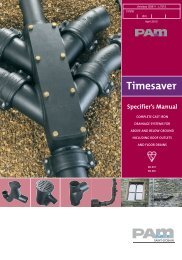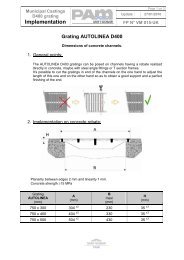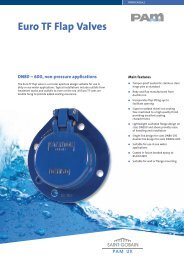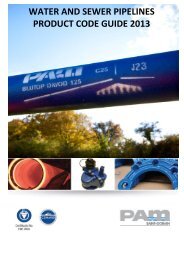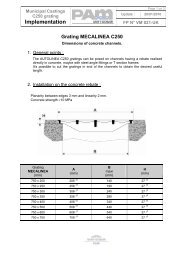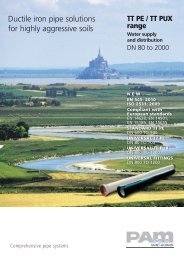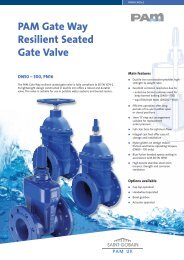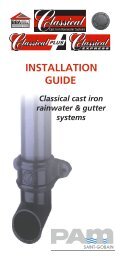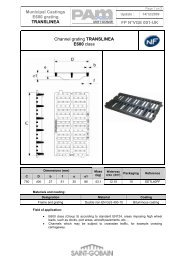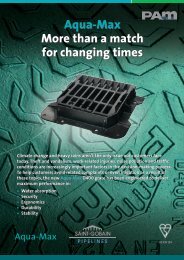Access Covers & Gratings Product Guide - Saint-Gobain PAM UK
Access Covers & Gratings Product Guide - Saint-Gobain PAM UK
Access Covers & Gratings Product Guide - Saint-Gobain PAM UK
You also want an ePaper? Increase the reach of your titles
YUMPU automatically turns print PDFs into web optimized ePapers that Google loves.
Channel grating<br />
Recommended bedding mortar<br />
Mecalinea installation<br />
Components<br />
M16 x 75<br />
bolt<br />
9<br />
8<br />
65<br />
30<br />
36<br />
Failure of the cementitious bedding mortar was found to be a principal<br />
cause of failure of road ironwork installations. Cracking of bedding<br />
material caused the ironwork to become loose. Cracking occurred<br />
due to a number of factors:<br />
• Shrinkage of the mortar during installation<br />
• Mortar having insufficient strength. Both compressive<br />
and tensile strain is built up during loading<br />
Installation<br />
Connecting piece<br />
RE 30 H3 ED<br />
E6<br />
Bearer bar<br />
RE 30 H3 GD (750 long)<br />
E5<br />
Installation<br />
Mecalinea grates should preferably be installed using the specially<br />
designed bearer bars and with the gratings joined together using the<br />
connecting pieces where used in cross traffic areas. Typical layout<br />
for heavy use and areas subject to slow-moving traffic.<br />
Detail A<br />
Grating connected to grating (must be used if subject to cross traffic).<br />
Detail B<br />
Bearer bar seating.<br />
• Installation opened to traffic too early<br />
• Differential stiffness between the access chamber<br />
and the surrounding road<br />
• Movement of the frame and flange of the casting<br />
under dynamic loading<br />
• Failure of the bond/adhesion between the casting<br />
and mortar giving rise to separation.<br />
An understanding of the behaviour of the ironwork under loading and the<br />
subsequent load transfer was developed along with the quantification of<br />
the strength (compressive and tensile) requirements of a bedding material.<br />
<strong>Saint</strong>-<strong>Gobain</strong> <strong>PAM</strong>’s engineers in collaboration with Weber SBD<br />
(manufacturers of specialist construction mortars) have developed the<br />
LTS feature, designed to increase the long-term performance of an<br />
ironwork installation. This includes LTS Polyester resin manhole<br />
bedding mortar which has been purpose-designed to provide:<br />
Installation<br />
• Long-term strength<br />
Detail B<br />
750 Bearer bar 750 Bearer bar 750 Bearer bar<br />
• Resistance to shrinkage<br />
Min rebate width<br />
Duct width<br />
• Long-term durability<br />
• Optimum workable properties<br />
• Early site opening<br />
Detail A<br />
• Consistency of performance.<br />
Used in combination with products that incorporate the LTS frame<br />
design feature, the polyester resin manhole bedding mortar will reduce<br />
the incidence of premature failure and improve the long-term performance<br />
of an ironwork installation.<br />
Strength properties<br />
The Nottingham University research identified and quantified the required<br />
strength to withstand the dynamic loading of a vehicle wheel. LTS bedding<br />
mortar exceeds this performance level in both compression and<br />
tensile load.<br />
May be bolted to duct<br />
Optimum workable properties<br />
Ease of installation is an important element in ensuring good site practice.<br />
The bedding mortar has been designed to allow enough working time<br />
to set the access cover and a ‘slump’ to give easy manipulation during<br />
bedding preparation.<br />
Durability<br />
Resistance is excellent to environmental conditions found in the highway.<br />
The mortar is resistant to the action of frost. It will not react chemically<br />
with de-icing salts. It has a low permeability which prevents damage to<br />
ironwork by chloride ingress.<br />
66<br />
67




